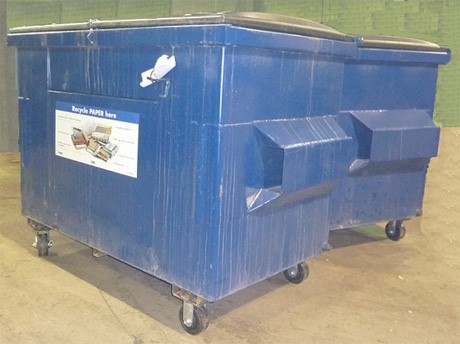Mobile industrial waste containers
Overview
Large metal mobile waste disposal containers are used at many workplaces, including:
- factories
- condominiums and high-rise apartment buildings
- shopping malls
- educational facilities (for example, schools or community centres)
These bins are typically made of steel and range in capacity from 1.5 to 4.6 cubic meters. Figure 1 shows a typical container.

Figure 1: Waste disposal container.
In some workplaces, workers must move these bins from an indoor location (where they have been filled) to an outdoor area so they can be emptied by a disposal truck.
Health risks
Workers may have to manually push or pull the containers if powered equipment is not available to perform this task which may result in health risks. The following are hazards that may increase the risk of injury to workers.
Excessive force
The forces required to manually push or pull a bin can be excessive. Workers can face an increased risk of developing a musculoskeletal disorder (MSD) due to these high forces.
The amount of force required to perform this task depends on several things, including the:
- weight of the container and the waste inside
- size and condition of the container
- type, size and condition of the castors
- surface the container is moved on
Cracked, damaged or uneven floors
If the floor surface is cracked or damaged or there are changes in elevation, there may be sudden increases in the amount of force that must be applied by the worker to keep the container moving or control its path. This further increases the risk of developing an MSD.
Losing control of the container
Workers, pedestrians or vehicles can be struck by a waste container if a worker loses control of a container while moving it.
There is an increased risk of a worker losing control of a container while manually moving it on a sloped surface such as a ramp. Forces are greater when pushing a container up a ramp and when trying to control it when moving down a ramp.
Vehicular traffic
Workers often move containers in areas where there is vehicular traffic, so safeguards must be in place to ensure they are not struck by vehicles.
Legal requirements
The following outlines the legal requirements under the Occupational Health and Safety Act (OHSA) regarding manually transferring mobile industrial waste containers:
Keep equipment in good condition
Under clause 25(1)(b), employers must make sure the equipment, materials and protective devices they provide are maintained in good condition.
Equipment that is in disrepair can increase the physical demands of workers. Castors and containers must be maintained to ensure they are in good condition.
Provide information, instruction and supervision
Under clause 25(2)(a), employers must provide workers with information, instruction and supervision to protect their health and safety.
Examples of information and instruction include:
- safe work procedures developed for moving industrial waste containers
- the hazards involving manually moving industrial waste containers
Communicate hazards
Under clause 25(2)(d), employers must make sure that workers or a person in authority over a worker (for example, supervisor or manager) are acquainted with the hazards in their work. This includes MSD hazards when manually moving industrial waste containers.
Take every precaution reasonable in the circumstances
Under clause 25(2)(h), employers must take every precaution reasonable in the circumstances for the protection of a worker, including from MSD and struck-by hazards when moving industrial waste containers.
See the section on how to prevent injuries for examples of precautions.
Regulations that apply
Some sector-specific OHSA regulations may also apply to manually moving industrial waste containers.
Under section 45 of Regulation 851 – Industrial Establishments, employers must make sure that materials, articles or things are:
- lifted, carried or moved in a way and with such precautions and safeguards that does not endanger the safety of a worker [clause 45(a)]
- transported, placed or stored so they can be removed or withdrawn without endangering the safety of any worker [subclause 45(b)(ii)]
- removed from a storage area, pile or rack in a manner that will not endanger the safety of a worker [clause 45(c)]
Under clause 11(a) of Regulation 851 – Industrial Establishments, the floor used by a worker must be kept free of obstructions, hazards, and accumulations of refuse, snow or ice.
Under section 20 of Regulation 851 – Industrial Establishments, barriers, warning signs, or other safeguards for the protection of all workers in an area must be used where vehicle or pedestrian traffic may endanger the safety of any worker.
How to prevent injuries
To reduce the risk of injury to workers moving industrial waste bins, here are recommended practices that an employer can take:
- Provide powered equipment, such as container pullers, tuggers or tractors with a hitch capable of supporting the loads that may be applied to it.
- Use castors with features that reduce push-pull efforts to acceptable limits.
- Ensure two or more workers move a container if it’s not possible to use powered equipment.
Force measurements may be required to verify that push-pull efforts will not increase the risk of developing an MSD.
An ergonomist can assist in determining acceptable limits and safe practices for moving these bins.
Related
Read CRE-MSD’s musculoskeletal disorder prevention guideline for Ontario